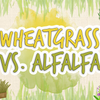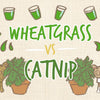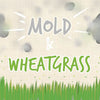Wheatgrass Vs Catnip | The Cat's Guide
Feeding catnip and wheatgrass to cats has become more common over the past few decades. This is because research findings have detailed the benefits of catnip and wheatgrass to cats. While catnip triggers a sense of euphoria due to its chemical constitution, wheatgrass helps to expel unwanted wastes such as hairballs from their system. This guide explores more differences between catnip and wheatgrass; including how they grow, consumption differences, and where they grow too.
What Is Wheatgrass?
Wheatgrass is 6-10 days old freshly sprouted wheat shoots. The sprouting process of wheatgrass enriches the shoots with essential nutrients. The sprouting process begins with soaking for about 8-12 hours followed by regular draining and rinsing every 12 hours to keep the growing microgreens well hydrated.
What Is Catnip?
Catnip (Nepeta cataria) is a strong-scented perennial mint that grows to between 20-40 inches. Catnip contains a chemical substance called nepetalactone that attracts cats. Nepetalactone oil activates pheromone receptors which are sex hormone receptors. Once these receptors have been activated the cat experiences an overwhelming sense of happiness that's usually accompanied by meowing, purring and friskiness. The blooming season for catnip begins in late spring and lasts through autumn and it takes 12 to 15 weeks to mature.
Are Wheatgrass And Catnip The Same?
Wheatgrass and catnip are two different plants that can be enjoyed as part of a cat’s diet. Catnip also has distinctive leaves and stems as opposed to wheatgrass that produces blade-like foliage.
Can Cats Eat Both Wheatgrass And Catnip?
Yes, cats can eat both wheatgrass and catnip. You can give 1 ounce of wheatgrass and a tablespoon of catnip to your cats on a daily basis to supplement their diet. Often a cat with intestinal distress will consume significantly more wheatgrass - up to 3oz. If your cat eats this much it's suggested to take them to the vet. Cats will often roll over catnips, paw at the plant, lick and even chew its leaves to enjoy its euphoric effect.
5 Differences Between Wheatgrass And Catnip
Growing
Wheatgrass - How Long To Grow: 6- 10 days
Sprouting wheatgrass in trays or pots takes about 2 days and a further 6-10 days to be ready for harvesting. Wheatgrass requires sufficient water and good airflow to sprout and grow fast.
Catnip - How Long To Grow: 5- 10 days
Catnip seeds take 5-10 days to sprout under the right conditions such as well-drained soil and adequate sunlight. Freezing the seeds overnight and soaking for 24 hours (stratification) enables catnip to germinate much faster. Catnip seeds may take up to 20 days to sprout under unfavorable conditions such as poorly drained soil. It takes 12-15 weeks for catnip leaves to be ready for harvesting.
Consuming
Wheatgrass - Cats consume wheatgrass by munching on the freshly sprouted wheatgrass to obtain nutrients. Wheatgrass juice may also be enticing to your cats. You can give 1 teaspoon of wheatgrass juice to your cat every day.
Catnip - Catnip acts as a sedative when ingested by cats. However, sniffing catnip makes cats go ‘crazy’ and will often flip over, roll around, and generally be hyperactive. The nepetalactone in catnip is thought to mimic feline sex pheromones in cats.
Where They Grow
Wheatgrass - Wheatgrass can be grown outdoors or indoors when exposed to the right conditions, such as indirect sunlight and adequate water. Also, the optimal temperature for growing wheatgrass should be between 70-80 degrees Fahrenheit.
Catnip - Catnip can also be grown indoors or outdoors as plants or seeds like wheatgrass. Catnip seeds are tough compared to wheatgrass seeds hence should be stratified through freezing overnight and soaking for 24 hours to make the seeds sprout faster.
Taste
Wheatgrass - Wheatgrass has a strong taste. The strong taste of wheatgrass leaves an earthly aftertaste in your mouth. To some, this kind of taste is described as raw yet pungent.
Catnip - Catnip has a woodsy taste, described by some as ‘almost grassy taste.
Smell
Wheatgrass - The smell of wheatgrass is described as fresh ‘green’ similar to newly-cut grass and may not be pleasing to other individuals.
Catnip - Catnip has an odor described as a ‘faint minty smell’ characteristic to its chemical substance known as nepetalactone.
Which Is Healthier For Cats?
Nutrients In catnip (per 100g serving size)
-
Tannins
-
Iridoids
-
Antioxidants
-
Volatile oil (mainly citronellol, alpha-and-beta nepetalactone, geraniol)
-
Vitamins C and E
-
Flavonoids
-
Minerals (especially manganese, chromium, potassium, iron, cobalt, and selenium)
Nutrients In wheatgrass (per 100g serving size)
-
Calories: 175
-
Sodium: 65mg (3% of DV)
-
Fat: 4.98g (6% of DV)
-
Protein: 28.36g
-
Calcium: 25g or 2% of DV
-
Vitamin C: 11.3g (13% of DV)
-
Potassium: 58mg, representing 1% of DV
-
Iron: 0.6mg, representing 3% of DV
Conclusion
Wheatgrass is important for cats because it helps to promote their digestive health and a vitamin boost. Catnip is also important for cats because it encourages movement and helps them to relieve stress.
Growing And Making Differences
Both wheatgrass and catnip are grown by sprouting their seeds. However, the sprouting process of catnip begins with stratification of the seeds to break their dormancy cycle to make them germinate quicker.
How To Grow Wheatgrass
Equipment Needed
-
Tray
-
Glass jar/sprouting container
-
Mesh
Supplies Needed
-
Water
-
3 tablespoons of sprout-ready wheat seeds
Instructions
1. Rinse the sprout-ready wheat seeds, place them in a glass jar/sprouting container, and cover with a mesh.
2. Add 1 cup of water to the wheatgrass seeds, soak for 8 hours, and drain and rinse thoroughly.
3. Fill the glass jar/sprouting container with water, invert it to drain water through the mesh, and leave it upside down.
4. Rinse the seeds 3 times daily for 3 days to acquire tiny sprouts.
5. Allow the wheatgrass sprouts to grow for 6-10 days before harvesting.
How To Grow Catnip
Equipment Needed
-
Water-filled spray bottle
-
2 sprouting tray
-
Plastic cover
-
Growing containers
Supplies Needed
-
Catnip seeds
-
Soil
Instructions
Part 1: Prepare your seeds through stratification
1. Freeze the catnip seeds overnight in a freezer bag.
2. Sprinkle the seeds in a bowl of hot water and soak for 12-24 hours.
Part 2: Planting the catnip seeds.
1. Add warm water to one of the sprouting trays to cover the catnip seeds.
2. Soak the seeds for 5-10 minutes.
3. Drain excess water from the sprouting tray.
4. Gently tear the middle part of each catnip seeds to make them grow faster.
5. Add soil to the second sprouting tray, dig shallow holes of about ⅛ inches, and drop 4 catnip seeds in each hole.
6. Add a tiny layer of soil on the sprouting tray and cover using the plastic cover.
7. Keep the sprouting tray in a warm dark place.
8. Little green catnip sprouts will appear in 14-15 days. Relocate the sprouting tray to a place with adequate sunlight and out of your cat’s reach.
9. Transfer your 4-5-inch catnip plant to growing containers in your indoor garden. Plant the catnip plants 18-20 inches apart.
Growing wheatgrass is easier and cheaper compared to catnip. This is because the whole process of growing wheatgrass takes about 10 days as opposed to catnip that matures for harvesting after 12-15 weeks. Wheatgrass requires little effort to sprout and maintain for a short time, which helps to avoid unforeseeable extra expenses for maintenance. This is opposed to catnip that takes up to 15 weeks to be ready for harvesting.
How Best For Cats To Consume
Consuming Wheatgrass
How Much Should Cats Eat?
Give 1 ounce of wheatgrass to your cat every day. For first-timers, start with smaller quantities of wheatgrass for your cat and increase the quantity daily.
Can Cats Eat Wheatgrass Everyday?
Yes. A daily dose of one tablespoon of wheatgrass is not harmful to your cat. You can also visit your vet for further advice after a quick check-up on the health status of your cat.
Juice - You can make wheatgrass juice for your cat by using 30 grams of wheatgrass, 1 cup of pineapple chunks, and a small piece of ginger. Wash your wheatgrass and fruits, place them in a high-powered blender, and blend thoroughly until smooth. This recipe is inspired by: indianhealthyrecipes.com.
Raw - You can grow wheatgrass for your cats by using seed trays, potting mix, wheatgrass seeds, newspaper, and watering can. Place the potting trays next to where your cats eat or drink water 10 days after sprouting so that they can eat and rub themselves against the wheatgrass. This raw wheatgrass sprout recipe is inspired by: pets.thenest.com
Consuming Catnip
How Much Can Cats Eat?
One tablespoon of catnip is relatively safe for your cats. You can increase the dosage after visiting your vet for health status assessment of your cats.
Cat Cats Eat Everyday?
Yes. Feeding your cat one teaspoon of catnip daily is relatively safe. Some cats may respond negatively towards catnip; hence there is a need to consult a vet.
Juice - You can extract catnip juice for your cats through steam distillation. After extracting the juice, allow your cat to get a good whiff that propels it to a frenzied state of scratching, sniffing, cage fighting, and rolling. This recipe is inspired by: instructables.com
Raw - To grow raw catnip for your cats, first, stratify your catnip seeds to make them germinate quicker. Soak your catnip seeds for 24 hours and plant them in average well-drained soil, water regularly, and ensure there is adequate sunlight. Ensure that you grow your catnip where your cats can rub and roll on the catnip. Your cats may also munch on the catnip leaves. This growing recipe is inspired by: bonnieplants.com
Where To Buy From
Wheatgrass - You can buy wheatgrass from health food stores and any grocery stores near you.
Catnip - Catnip can be purchased from pet stores, grocery stores or you can order catnip products such as catnip spray from Amazon.
History Of Catnip And Wheatgrass
Wheatgrass - The history of wheatgrass can be traced back to more than 5000 years ago and is believed to have originated from Egypt. Additional research findings have also indicated that the history of wheatgrass can also be traced back to early Mesopotamian civilization.
Catnip - Catnip, or otherwise known as Nepeta cataria, catwort, or catmint is a plant species. It is native to places such as eastern and southern Europe, Africa, Central Asia, the Middle East, and parts of China. Additionally, catnip is also naturally neutralized in places such as New Zealand, northern Europe, and North America, among other places around the world.
Risks Associated With Cats Eating Wheatgrass And Catnip
Catnip - Although catnip is considered to be relatively safe, your cat may experience complications such as diarrhea and vomiting. These conditions are, however, rare and self-limiting. Incase such complications occur; it is advisable to withhold or limit the quantity of catnip consumed by your cats.
Wheatgrass - Contrary to its health benefits, wheatgrass has side effects such as indigestion and the threat of poisoning when given to cats. Wheatgrass is known to cause gastric disorder in cats of all ages and breeds and may lead to further complications such as dehydration and loss of appetite for your cats. Herbicides and other dangerous chemicals used to treat wheatgrass may also cause poisoning in cats.
Juice Powders
What Are They?
Juice powders are processed foods in powder form. Mixing juice powders with water leads to a beverage similar to fruit juice or soda.
Can Cats Consume Juice Powders?
Yes. Cats can feed on juice powders as diet supplements, a serving of up to 1 oz is considered harmless.
Wheatgrass
Wheatgrass powder is essential in your cat’s diet because it helps your cats with weight loss, hormone balancing, enhancing pain relief, improves their dental health, and aids the removal of fluoride and heavy metals.
Common Questions
Is Wheatgrass Toxic To Cats?
Wheatgrass is not toxic for cats. Giving wheatgrass to your cats helps to improve their health through organ cleansing, boosting their energy, and breath freshening. Too much wheatgrass may also lead to vomiting which aids in the expulsion of feathers and hairballs.
Does Wheatgrass Make Cats Throw Up?
Yes, when cats overeat wheatgrass it can trigger side effects such as vomiting . This is because cats do not have the enzymes required to digest wheatgrass and other grasses.
What Kind Of Grass Is Best For Cats?
Wheatgrass and lemongrass are considered to be the best for cats. They are packed with essential nutrients to improve the health of your cat.
Should Indoor Cats Eat Grass?
Yes. Feeding grass to indoor cats is essential for their health because it helps to induce regurgitation to enhance digestion, provides them with vital minerals and vitamins, and gives them a laxative appeal.
Is Wheatgrass Good For Kidneys?
Wheatgrass is good for cats with kidney disease/chronic renal failure (CRF). The chlorophyll content in wheatgrass helps to counter the anemia caused by CRF.
Is Wheatgrass Good For Pets?
Yes. Wheatgrass is good for pets like cats and dogs because it boosts their digestion, acts as antioxidants, helps with constipation, boosts their energy, and facilitates organ cleansing, among other benefits.
Is Wheatgrass The Same As Cat Grass?
Wheatgrass is the same as cat grass. This is because cat grass can be grown by sprouting wheatgrass to enhance its nutritional content.
Can Cats Digest Wheatgrass?
Cats cannot digest wheatgrass. Feeding cats on too much wheatgrass may lead to gastric disorder, indigestion and secondary side effects such as dehydration and loss of appetite.
Is Wheat Gluten Bad For Cats?
Wheat gluten is bad for cats because it may cause allergic reactions to your cats. Gluten may be contaminated with melamine hence leading to poisoning for cats.
Can A Cat Eat Too Much Cat Grass?
Giving too much cat grass to your cats may cause health complications such as diarrhea and vomiting.
How Do You Give Wheatgrass To A Cat?
Allow your cats to eat wheatgrass to their fill because they do not have the necessary enzymes for digesting grass hence they will self-regulate the amount of grass to eat.







